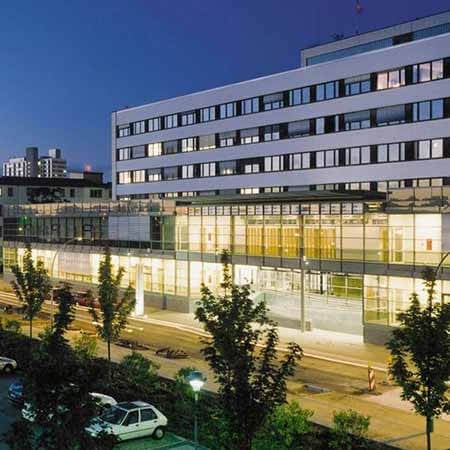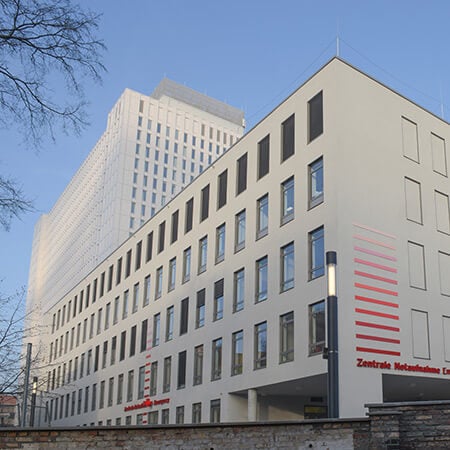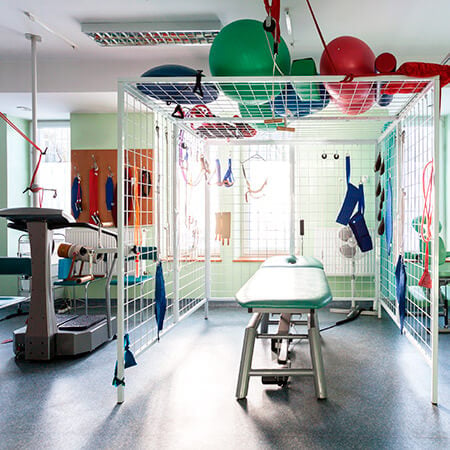Myasthenia
Due to the difficulties associated with the organization of treatment in Turkey, Switzerland, South Korea and India, we are not currently processing requests to these regions.
If you are interested in treatment in Germany, please leave a request and our specialists will contact you as soon as possible.
Myasthenia is a pathological weakness and high skeletal muscles fatigue. The disease is more often diagnosed at a young age, in teenagers and 6-7 years old children. Myasthenia can affect muscles that are responsible for the respiratory function. Hence, without medical care a patient can die because of acute respiratory failure during the myasthenic crisis.
The Booking Health portal presents 65 German clinics specializing in myasthenia treatment
Show all clinics
Myasthenia – Diagnostics
Diagnostics is based on the clinical examination of the patient. The degree of motor disorders in the limbs muscles is rated from zero to five:
- 5 – movements in the limbs are fully preserved;
- 4 – muscle weakness is observed;
- 3 – sharp decrease of the muscle strength;
- 2 – it is hard for a patient to hold the weight of the limb;
- 1 – a patient is unable to hold the weight of the limb;
- 0 – movements in the muscle (limbs) are absent.
Other muscle groups condition is also assessed depending on the clinical stage of myasthenia. Various tests are performed to assess the strength of the neck muscles, detect ptosis, speech, breathing, and swallowing disorders. All malfunctions are counted in points and the severity of myasthenia is determined.
Laboratory diagnostics. One of the main criteria is the increased level of autoantibodies to the acetylcholine muscle receptor in the blood serum. This indicator is important not only for establishing the diagnosis but also for assessing the effectiveness of the therapeutic procedures used.
Other laboratory methods of diagnostics are:
- Patients with thymoma or late onset of myasthenia without thymoma are tested for antibodies to the protein titin.
- The blood level of antibodies to ryanodine receptors of sarcoplasmic reticulum may increase. This is an unfavourable prognostic sign observed in 35% of patients when myasthenia is combined with thymoma.
- In patients with seronegative myasthenia, antibodies to muscle-specific tyrosine kinase are detected in about half of the cases.
Instrumental diagnostics. Electromyography is one of the basic methods that help to detect a violation of neuromuscular transmission. With the help of EMG one can compare the degree of involvement of different muscles in the pathological process, such as: masticatory, respiratory, facial, or musculature of the extremities.
Methods of imaging (CT, MRI) can be used to identify thymoma in the mediastinum. However, the tumour of the thymus gland doesn’t clearly indicate the presence of myasthenia, and therefore can’t be considered a diagnostic criterion.
Proserin test. The patient receives anticholinesterase drugs. They temporarily improve the neuromuscular transmission, increasing the strength of the muscles. The sensitivity of the test is about 90%. The increase in the strength of damaged muscles after the introduction of proserin confirms the diagnosis.
Best clinics for the myasthenia diagnostics in Germany:
Myasthenia – Treatment
Conservative treatment includes the use of anticholinesterase drugs, potassium and potassium-sparing diuretics. To enhance the effectiveness of therapy, glucocorticoid hormones are used to suppress autoimmune processes. They are effective in 80% of patients. If the results are unsatisfactory, then cytotoxic agents are prescribed.
Different forms and stages of myasthenia (acute, chronic, crisis) demand different treatment approaches. Hence, an experienced doctor should be engaged in selecting the optimal therapy program. It helps to minimize the risk of the side effects, including the risk of cholinergic crisis, which is a consequence of drug therapy used for myasthenia. In German hospitals specialists choose the best treatment programs for their patients with the use of the latest medicines.
Plasmapheresis or hemadsorption is and extracorporeal (outside the body) blood purification method that can remove autoantibodies that destroy cholinesterase receptors in the muscles. This allows to achieve a temporary clinical improvement.
Treatment of the myasthenic crisis includes:
- Intubation of the trachea and performing artificial lungs ventilation if there is a sharp weakness of the respiratory muscles
- Control of blood gas composition
- Plasmapheresis
- The introduction of immunoglobulins
Surgery is performed in a number of cases. It is based on the thymus removal. Indications for the operation are:
- Presence of thymus tumour
- Progression of myasthenia
- Bulbar form of the disease (accompanied by a violation of swallowing and speech)
- Generalized form of myasthenia in children
Average effectiveness of thymus removal is about 70%. A part of these patients are completely healed from myasthenia, others have a significant clinical improvement which means that the doses of the medicines are reduced.
Best clinics for the myasthenia treatment in Germany:

Beta Clinic Bonn

Bundeswehr Hospital Berlin

Charite University Hospital Berlin
Myasthenia – Rehabilitation
Rehabilitation is the process of body restoration from injuries, surgeries or diseases. It can have a different orientation such as: oncological, orthopedic, neurological, etc. There is also general therapeutic rehabilitation. It is indicated for patients after conservative and surgical treatment of the internal organs diseases.
The directions of the rehabilitation
There are several main directions of the rehabilitation such as:
- Medical one, which includes the restoration of patient's health, normalization of body functions, stimulation of compensatory possibilities, elimination of the chronic pain, etc.
- Physical one, which is responsible for improving of work capacity and tolerance for physical activities. In the complex cases, the purpose of this therapeutic rehabilitation area may be the restoration of the self-service ability.
- Psychological one, which helps to eliminate the mental disorders which may occur as a result of a disease (phobias, depression, apathy), to increase the human motivation, and to adapt to the changed living conditions.
The World Health Organization underlines 3 phases of rehabilitation such as: hospital phase, a phase of recovery and supporting phase. Different tasks are solved in different phases. The hospital phase is conducted immediately after the treatment. After the first phase begins the second one which usually takes place in sanatoriums or rehabilitation centers. This is the boundary between two periods, namely illness and future life. Then a supporting phase is required. The patient maintains the achieved level of his health and physical activity at home or visits the rehabilitation center from time to time.
Rehabilitation methods
The most modern rehabilitation programs are used in Germany. They are adapted individually for each patient, and are based on the recent disease, age, physical possibilities, and the results of treatment. Different specialists such as: therapists, psychologists, rehabilitators, kinesiotherapists, physiotherapists are involved in the rehabilitation process.
The following methods of rehabilitation are used:
- Dosed physical activity
- Training on the simulators and in the pool
- Physiotherapy
- Acupuncture
- Manual therapy
- Microcurrent therapy
- Compression therapy
- Lymphatic drainage
- Natural factors of the nature (mud, thermal waters, etc.)
Any rehabilitation may include medicamentous support. It is necessary to hold a consultation with the patient about the proper nutrition and the way of life which is important for him in the current situation.
Rehabilitation programs in Germany are designed for 2 weeks. If necessary, they can last much longer. In this country, the patient is provided with qualitative care, accommodation in comfortable rooms and individually selected meals.
Rehabilitation programs in Germany show one of the best results in the world. Most patients successfully restore their employability and excellent health there. They remain physically active, return to the full social and family life.
Best clinics for neurological rehabilitation in Germany:
Author:
The article was edited by medical expert, board certified Dr. Nadezhda Ivanisova. For the treatment of the conditions referred to in the article you must consult a doctor; the information in the article is not intended for self-medication!
Sources:
NORD - National Organization for Rare Disorders
The cost of services includes
Here you can find the cost of treatment for this disease at the German University Hospitals. Leave a request and we will provide a free consultation with a doctor and will start organizing the whole treatment process.
The program includes the following:
- Issuing of an invitation for getting a visa for treatment as quick as possible
- Fixing an appointment at a time convenient for you
- Preliminary organization of a comprehensive examination and discussion of the forthcoming treatment plan
- Arranging transfer from the airport to the hospital and back to the airport
- Provision of interpreting services and services of a personal medical coordinator
- If necessary, assistance in the organization of further surgical treatment
- Provision of a medical insurance against treatment complications covering up to 200,000 euro
- Preparation and translation of medical records and recommendations from the hospital
- Assistance in the subsequent communication with your attending physician, including consultations on repeated X-ray images through the unique medical document management system E-doc
